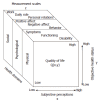Surgical perspectives in gastrointestinal disease: a study of quality of life outcomes in esophageal, pancreatic, colon, and rectal cancers
- PMID: 16718841
- PMCID: PMC4087964
- DOI: 10.3748/wjg.v12.i20.3213
Surgical perspectives in gastrointestinal disease: a study of quality of life outcomes in esophageal, pancreatic, colon, and rectal cancers
Abstract
Outcomes assessment in surgery traditionally has included data regarding peri-operative mortality and morbidity, as well as long-term survival and recurrence in surgical oncology. However, quality of life (QOL) is another important patient-related outcome measure. QOL data can be used to tailor treatment and improve clinical outcomes by detecting physical or psychological problems in patients that otherwise might be overlooked, but which have profound implications for the effective delivery of care. We review several well-validated QOL instruments developed specifically for use in patients with gastrointestinal malignancies, including esophageal, pancreatic and colorectal cancers, and conclude that QOL assessment routinely should be included in clinical trials of novel treatments.
Figures



References
-
- Testa MA, Simonson DC. Assesment of quality-of-life outcomes. N Engl J Med. 1996;334:835–840. - PubMed
-
- Spilker Bert. Quality of Life and Pharmocoeconomics in Clinical Trials. 2nd edition. New York: Lippincott-Raven Publishers; 1996. p. 41.
-
- War JE, SnowKK , Kosinski M, Gandek B. SF-36 Health Survey manual and Interpretation Guide. Boston, MA: The Health Institute; 1993.
-
- Alonso J, Ferrer M, Gandek B, Ware JE Jr, Aaronson NK, Mosconi P, Rasmussen NK, Bullinger M, Fukuhara S, Kaasa S, et al. Health-related quality of life associated with chronic conditions in eight countries: results from the International Quality of Life Assessment (IQOLA) Project. Qual Life Res. 2004;13:283–298. - PubMed
-
- Camilleri-Brennan J, Steele RJ. Measurement of quality of life in surgery. J R Coll Surg Edinb. 1999;44:252–259. - PubMed
Publication types
MeSH terms
LinkOut - more resources
Full Text Sources
Medical

